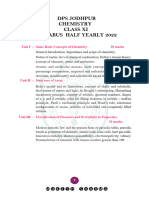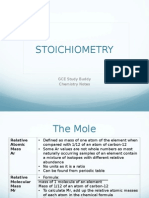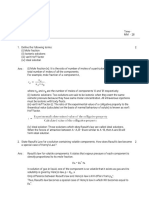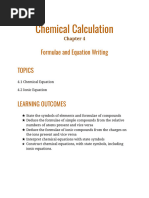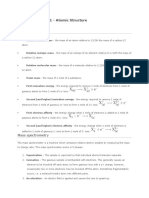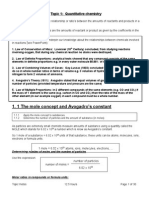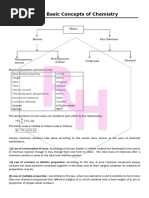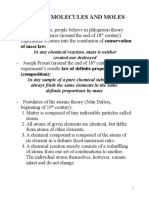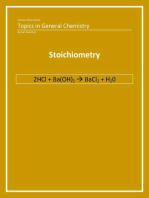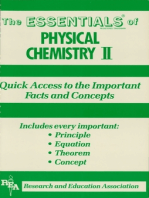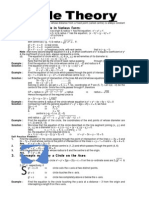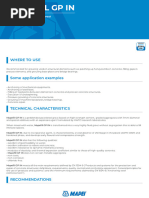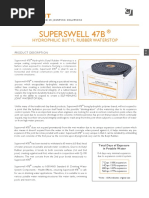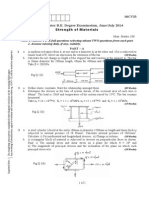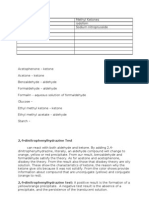Chemistry - Study of Matter
Chemistry - Study of Matter
Uploaded by
Sachin KumarCopyright:
Available Formats
Chemistry - Study of Matter
Chemistry - Study of Matter
Uploaded by
Sachin KumarOriginal Description:
Original Title
Copyright
Available Formats
Share this document
Did you find this document useful?
Is this content inappropriate?
Copyright:
Available Formats
Chemistry - Study of Matter
Chemistry - Study of Matter
Uploaded by
Sachin KumarCopyright:
Available Formats
CHEMISTRY STUDY OF MATTER
Overview of Chemistry
Friends for you used in the sheet.
1. Teacher's advice : Tips which can enhance your performance.
2. Student's query : Arbit doubts which are generally developed among students.
3. Boost your confidence : Some additional information.
4. Dangers Take care of the general mistakes and crucial points.
KEY CONCEPTS
1. LAWS OF CHEMICAL COMBINATION
1.1 Law of conservation of mass [Lavoisier]
1.2 Law of constant composition [Proust]
1.3 Law of multiple proportions [Dalton]
1.4 Law of reciprocal proportions [Richter]
1.5 Gay Lussac law of combining volumes [Guess Who??]
"Wonder these laws are useful?"
"These are no longer useful in chemical calculations now but gives an idea of
earlier methods of analysing and relating compounds by mass."
2. MOLE CONCEPT
2.1 Definition of mole : One mole is a collection of that many entities as there are number of
atoms exactly in 12 gm of C-12 isotope.
or 1 mole = collection of 6.02 10
23
species
6.02 10
23
= N
A
= Avogadro's No.
` 1 mole of atoms is also termed as 1 gm-atom, 1 mole of ions is termed as 1 gm-ion and
1 mole of molecule termed as 1 gm-molecule.
2.2 Methods of Calculations of mole :
(a) If no. of some species is given, then no. of moles =
A
N
. no Given
(b) If weight of a given species is given, then no of moles =
. wt Atomic
. wt Given
(for atoms),
or =
. wt Molecular
. wt Given
(for molecules)
(c) If volume of a gas is given along with its temperature (T) and pressure (P)
use n =
RT
PV
where R = 0.0821 lit-atm/mol-K (when P is in atmosphere and V is in litre.)
1 mole of any gas at STP occupies 22.4 litre.
Gases do not have volume. What is meant by "Volume of gas"?
Do not use this expression (PV = nRT) for solids/liquids.
How would I calculate moles if volume of a solid is given?
2.3 Atomic weight:It is the weight of an atom relative to one twelvth of weight of 1 atom of C-12
Be clear in the difference between 1 amu and 1 gm.
(a) Average atomic weight = % of isotope X molar mass of isotope.
The % obtained by above expression (used in above expression) is by number (i.e. its a mole%)
2.4 Molecular weight : It is the sum of the atomic weight of all the constituent atom.
(a) Average molecular weight =
i
i i
n
M n
where n
i
= no. of moles of any compound and m
i
= molecular mass of any compound.
Make yourselves clear in the difference between mole% and mass% in question related to
above.
Shortcut for % determination if average atomic weight is given for X having isotopes X
A
& X
B
.
% of X
A
=
B A
B
X & X of weight in difference
X of wt weight atomic Average
100
Try working out of such a shortcut for X
A
, X
B
, X
C
3. EMPIRICAL FORMULA, MOLECULAR FORMULA :
3.1 Empirical formula : Formula depicting constituent atom in their simplest ratio.
Molecular formula : Formula depicting actual number of atoms in one molecule of the compound
3.2 Relation between the two : Molecular formula = Empirical formula n
n =
mass Formula Empirical
mass Molecular
Check out the importance of each step involved in calculations of empirical formula.
3.3 Vapour density :
Vapour density : Ratio of density of vapour to the density of hydrogen at similar pressure and
temperature.
Vapour density =
2
mass Molecular
Can you prove the above expression?
Is the above parameter temperature dependent?
4. STOICHIOMETRY : Stoichiometry pronounced (stoy key om e tree) is the calculations of
the quantities of reactants and products involved in a chemical reaction.
This can be divided into two category.
(A) Gravimetric analysis
(B) Volumetric analysis (to be discussed later)
4.1 Gravimetric Analysis :
4.1.1 Methods for solving :
(a) Mole Method
(b) Factor Label Method
required reaction Balance
)
`
(c) POAC method } Balancing not required but common sense use it with slight caree.
(d) Equivalent concept } to be discussed later
5. CONCEPT OF LIMITING REAGENT.
5.1 Limiting Reagent : It is very important concept in chemical calculation. It refers to reactant
which is present in minimum stoichiometry quantity for a chemical reaction. It is reactant consumed fully
in a chemical reaction. So all calculations related to various products or in sequence of reactions are
made on the basis of limiting reagent.
It comes into picture when reaction involves two or more reactants. For solving any such reactions,
first step is to calculate L.R.
5.2 Calculation of Limiting Reagent :
(a) By calculating the required amount by the equation and comparing it with given amount.
[Useful when only two reactant are there]
(b) By calculating amount of any one product obtained taking each reactant one by one irrespective
of other reactants. The one giving least product is limiting reagent.
(c) Divide given moles of each reactant by their stoichiometric coefficient, the one with least ratio is
limiting reagent. [Useful when number of reactants are more than two.]
6. PERCENTAGE YIELD : The percentage yield of product =
100
yield maximum l theoretica the
yield actual
The actual amount of any limiting reagent consumed in such incomplete reactions is given by
[% yield given moles of limiting reagent] [For reversible reactions]
For irreversible reaction with % yield less than 100, the reactants is converted to product (desired)
and waste.
7. CONCENTRATION TERMS :
7.1 General concentraction term :
(a) Density =
Volume
Mass
, Unit : gm/cc
(b) Relative density =
substance refrence of Density
ance any subst of Density
(c) Specific gravity =
C 4 at water of Density
ance any subst of Density
(d) Vapour density =
pressure and e temperatur same at gas of Density
pressure and e temperatur some at vapour of Density
2
H
(1) Which of these are temperature dependent.
(2) Classify them as w/w, w/v, v/v ratio.
7.2 For solutions (homogeneous mixture) :
What is solute and solvent in a solution.
If the mixture is not homogeneous, then none of them is applicable.
Classify each given ratio as w/w, w/v, v/v and comment on their temperature dependence.
(a) % by mass
|
\
|
W
w
: =
solution of . wt
solute of . wt
100
[X % by mass means 100 gm solution contains X gm solute ; (100 X) gm solvent ]
(b) %
|
\
|
V
w
: = 100
solution of volume
solute of . wt
[for liq. solution]
[X %
|
\
|
V
w
means 100 ml solution contains X gm solute ]
for gases % by volume is same as mole %
(c) %
|
\
|
V
v
: =
100
solution of volume
solute of volume
(d) Mole % : = 100
moles Total
solute of Moles
(e) Mole fraction (X
a
) : =
moles Total
solute of Moles
(f) Molarity (M) : =
Mole of solute
volume of solution in litre
(g) Molality (m) : =
) kg in ( solvent of Mass
solute of Moles
(h) Parts per million (ppm) : =
6
10
solvent of Mass
solute of Mass
solution of Mass
solute of Mass
10
6
Get yourselves very much confortable in their interconversion. It is very handy.
7.3 Some typical concentration terms :
(a) Oleum : Labelled as '% oleum' (for e.g. 102% oleum), it means maximum amount of H
2
SO
4
that can be obtained from 100 gm of such oleum (mix of H
2
SO
4
and SO
3
) by adding sufficient
water.
Work out what are the maximum and minimum value of the %
(b) H
2
O
2
: Labelled as 'volume H
2
O
2
(for e.g. 20V H
2
O
2
), it means volume of O
2
(in litre) at STP
that can be obtained from 1 litre of such a sample when it decomposes according to
H
2
O
2
H
2
O +
2
1
O
2
Work out a relationship between M and volume H
2
O
2
and remember it
8. SOME EXPERIMENTAL METHODS :
8.1 For determination of atomic mass :
(a) Dulong's and Petit's Law :
Atomic weight specific heat (cal/gmC) 6.4
Gives approximate atomic weight and is applicable for metals only. Take care of units of
specific heat.
(b) Mass spectrometry :
r
mv
2
= qvB
d
B
B is the magnitude of magnetic field r = d/2
m is mass of ion, v is velocity of ion, r is the distance where the ions strikes, q is the charge on
the ion.
8.2 For molecular mass determination :
(a) Victor Maeyer's process : (for volatile substance)
Procedure : Some known weight of a volatile substance (w) is taken, converted to vapour and
collected over water. The volume of air displaced over water is given (V) and the following
expressions are used.
M =
RT
PV
w
or M =
RT
V ) ' P P (
w
If aq. tension is not given If aq. tension is P'
Aqueous tension : Pressure exerted due to water vapours at any given temperature.
This comes in picture when any gas is collected over water. Can you guess why?
(b) Silver salt method : (for organic acids)
Basicity of an acid : No. of replacable H
+
atoms in an acid (H contained to more electronegative
atom is acidic)
Procedure : Some known amount of silver salt (w
1
gm) is heated to obtain w
2
gm of while
shining residue of silver. Then if the basicity of acid is n, molecular weight of acid would be
1 salt
2
w M
n
1
108
w
=
|
|
\
|
and molecular weight of acid = M
salt
n(107)
This is one good practical application of POAC.
P
a
g
e
8
o
f
2
4
M
O
L
E
C
O
N
C
E
P
T (c) Chloroplatinate salt method : (for organic bases)
Lewis acid : electron pair acceptor
Lewis base :electron pair donor
Procedure : Some amount of organic base is reacted with H
2
PtCl
6
and forms salt known as
chloroplatinate. If base is denoted by B then salt formed
(i) with monoacidic base = B
2
H
2
PtCl
6
(ii) with diacidic base = B
2
(H
2
PtCl
6
)
2
(iii) with triacidic base = B
2
(H
2
PtCl
6
)
3
The known amount (w
1
gm) of salt is heated and Pt residue is measured. (w
2
gm). If acidity of base is 'n'
then
1 salt
2
w M
n
1
195
w
=
|
|
\
|
and M
base
=
2
) 410 ( n M
salt
8.3 For % determination of elements in organic compounds :
All these methods are applications of POAC
Do not remember the formulas, derive them using the concept, its easy.
(a) Liebig's method : (Carbon and hydrogen)
) w ( O H CO ) w ( Compound Organic ) w (
2 2 2 1
CuO
+
% of C =
100
w
12
44
w
1
% of H =
100
w
1
18
w
2
where w
1
= wt. of CO
2
produced, w
2
= wt. of H
2
O produced,
w = wt. of organic compound taken
(b) Duma's method : (for nitrogen)
(w) Organic Compound
CuO
N
2
(P, V, T given)
use PV = nRT to calculate moles of N
2
, n.
% of N =
100
w
28 n
w = wt of organic compound taken
(c) Kjeldahl's method : (for nitrogen)
(w)O.C.+H
2
SO
4
(NH
4
)
2
SO
4
NaOH
NH
3
+ H
2
SO
4
(molarity and volume (V
1
)
consumed given)
% of N =
100
w
14 2 MV
1
where M = molarity of H
2
SO
4
.
Some N containing compounds do not give the above set of reaction as in Kjeldahl's method.
(d) Sulphur :
(w) O.C. + HNO
3
H
2
SO
4
+ BaCl
2
(w
1
) BaSO
4
% of S =
% 100 32 1
233
w
1
.
where w
1
= wt. of BaSO
4
, w = wt. of organic compound
(e) Phosphorus :
O.C + HNO
3
H
3
PO
4
+ [NH
3
+ magnesia mixture ammonium molybdate] MgNH
4
PO
4
Mg
2
P
2
O
7
% of P =
100
w
31 2
222
w
1
(f) Carius method : (Halogens)
O.C. + HNO
3
+ AgNO
3
AgX
If X is Cl then colour = white
If X is Br then colour = dull yellow
If X is I then colour = bright yellow
Flourine can't be estimated by this
% of X =
100
w
) X of . wt . At ( 1
) AgX of weight . M (
w
1
9. EUDIOMETRY : [For reactions involving gaseous reactants and products]
The stoichiometric coefficient of a balanced chemical reactions also gives the ratio of volumes in
which gasesous reactants are reacting and products are formed at same temperature and pressure.
The volume of gases produced is often given by mentioning certain solvent which absorb contain
gases.
Solvent gas (es) absorb
KOH CO
2
, SO
2
, Cl
2
Ammon Cu
2
Cl
2
CO
Turpentine oil O
3
Alkaline pyrogallol O
2
water NH
3
, HCl
CuSO
4
H
2
O
Check out for certain assumption which are to be used for solving problem related to this.
EXERCISE # I
LAWS OF CHEMICAL COMBINATION
Q.10 What mass of sodium chloride would be decomposed by 9.8 gm of sulphuric acid, if 12 gm of sodium
bisulphate and 2.75 gm of hydrogen chloride were produced in a reaction assuming that the law of
conservation of mass is true?[Assume none of the reactants are remaining] [Ans. 4.95 gm]
Q.12 Zinc sulphate crystals contain 22.6% of zinc and 43.9% of water. Assuming the law of constant proportions
to be true, how much zinc should be used to produce 13.7 gm of zinc sulphate crystal and how much
water will they contain?
Q.13 Carbon combines with hydrogen to form three compounds A, B and C. The percentage of hydrogen in
A, B and C are 25, 14.3 and 7.7 respectively. Which law of chemical combination is illustrated?
[Ans. law of multiple proportions]
Q.14 Illustrate the law of reciprocal proportions from the following data : KCl contains 52.0% potassium, KI
contains 23.6% potassium and ICl contains 78.2% iodine.
ATOMIC MASS & MOLECULAR MASS
Q.1 The average mass of one gold atom in a sample of naturally occuring gold is 3.2707 10
22
g. Use this
to calculate the molar mass of gold.
Q.2 A plant virus is found to consist of uniform symmetrical particles of 150 in diameter and 5000 long.
The specific volume of the virus is 0.75 cm
3
/g. If the virus is considered to be a single particle, find its
molecular weight.
Q.3 Density of a gas relative to air is 1.17. Find the mol. mass of the gas. [M
air
= 29g/mol]
MOLE
Q.4 If all 1 billion (10
9
) people in India were put to work counting the atoms in a mole of gold and if each
person could count one atom per second day and night for 365 days a year, how many years would it
take to finish the count ?
Q.5 Vitamin C, ascorbic acid, has the formula C
6
H
8
O
6
.
(a) The recommended daily dose of vitamin C is 60 milligrams. How many moles are you consuming if you
ingest 60 mg of the vitamin ?
(b) A typical tablet contains 1.00 g of vitamin C. How many moles of vitamin C does this represent ?
(c) When you consume 1.00 gram of vitamin C, how many oxygen atoms are you eating ?
Q.6 Precious metals such as gold and platinum are sold in units of troy ounces,where 1 troy ounce is 31.1
grams. If you have a block of platinum with a mass of 15.0 troy ounces, how many mole of the metal do
you have ? What is the size of the block in cubic centimeters ? (The density of platinum is 21.45 g/cm
3
at
20C) (Atomic wt.of Pt. = 195)
Q.7 One type of artifical diamond (commonly called YAG for yttrium aluminium garnet) can be represented
by the formula Y
3
Al
5
O
12
.
(a) Calculate the weight percentage composition of this compound.
(b) What is the weight of yttrium present in a 200 carat YAG if 1 carat - 200 mg ? (Y = 89, Al = 27)
Q.8 A chemical commonly called dioxin has been very much in the news in the past few years. (It is the by
product of herbicide manufacture and is thought to be quite toxic.) Its formula is C
12
H
4
Cl
4
O
2
. If you
have a sample of dirt (28.3 g) that contains 1.0 10
4
% dioxin, how many moles of dioxin are in the dirt
sample ?
LIMITING REACTANT
Q.9 Titanium, which is used to make air plane engines and frames, can be obtained from titanium tetrachloride,
which in turn is obtained from titanium oxide by the following process :
3 TiO
2
(s) + 4C (s) + 6Cl
2
(g) 3TiCl
4
(g) + 2CO
2
(g) + 2CO (g)
A vessel contains 4.15 g TiO
2
, 5.67 g C and; 6.78 g Cl
2
, suppose the reaction goes to completion as
written, how many gram of TiCl
4
can be produced ? (Ti = 48)
Q.10 A chemist wants to prepare diborane by the reaction
6 LiH + 8BF
3
6Li BF
4
+ B
2
H
6
If he starts with 2.0 moles each of LiH & BF
3
. How many moles of B
2
H
6
can be prepared.
Q.11 When you see the tip of a match fire, the chemical reaction is likely to be
P
4
S
3
+ 8O
2
P
4
O
10
+ 3SO
2
What is the minimum amount of P
4
S
3
that would have to be burned to produce at least 1.0 g of P
4
O
10
and at least 1.0 g of SO
2
GRAVIMETRIC ANALYSIS
Q.12 1 gm sample of KClO
3
was heated under such conditions that a part of it decomposed according to the
equation (1) 2KClO
3
2 KCl + 3O
2
and remaining underwent change according to the equation.
(2) 4KClO
3
3 KClO
4
+ KCl
If the amount of O
2
evolved was 146.8 ml at S.T.P., calculate the % by weight of KClO
4
in the residue.
Q.13 A sample of calcium carbonate contains impurities which do not react with a mineral acid. When 2 grams
of the sample were reacted with the mineral acid, 375 ml of carbon dioxide were obtained at 27C and
760 mm pressure. Calculate the % purity of the sample of CaCO
3
?
Q.14 One gram of an alloy of aluminium and magnesium when heated with excess of dil. HCl forms magnesium
chloride, aluminium chloride and hydrogen. The evolved hydrogen collected over mercury at 0C has a
volume of 1.2 litres at 0.92 atm pressure. Calculate the composition of the alloy.
Q.15 A sample containing only CaCO
3
and MgCO
3
is ignited to CaO and MgO. The mixture of oxides
produced weight exactly half as much as the original sample. Calculate the percentages of CaCO
3
and
MgCO
3
in the sample.
Q.16 Determine the percentage composition of a mixture of anhydrous sodium carbonate and sodium
bicarbonate from the following data:
wt. of the mixture taken = 2g
Loss in weight on heating = 0.124 g.
Q.17 A 10 g sample of a mixture of calcium chloride and sodium chloride is treated with Na
2
CO
3
to precipitate
calcium as calcium carbonate. This CaCO
3
is heated to convert all the calcium to CaO and the final mass
of CaO is 1.62g. Calculate % by mass of NaCl in the original mixture.
Q.18 In a gravimetric determination of P an aqueous solution of NaH
2
PO
4
is treated with a mixture of
ammonium and magnesium ions to precipitate magnesium ammonium phosphate Mg(NH
4
)PO
4
. 6H
2
O.
This is heated and decomposed to magnesium pyrophosphate, Mg
2
P
2
O
7
which is weighed. A solution
of NaH
2
PO
4
yielded 1.054 g of Mg
2
P
2
O
7
. What weight of NaH
2
PO
4
was present originally ?
Q.19 By the reaction of carbon and oxygen, a mixture of CO and CO
2
is obtained. What is the composition
of the mixture obtained when 20 grams of O
2
reacts with 12 grams of carbon ?
Q.20 A mixture of nitrogen and hydrogen. In the ratio of one mole of nitrogen to three moles of hydrogen, was
partially converted into NH
3
so that the final product was a mixture of all these three gases. The mixture
was to have a density of 0.497 g per litre at 25C and 1.00 atm. What would be the mass of gas in
22.4 litres at S.T.P? Calculate the % composition of this gaseous mixture by volume.
Q.21 Direct reaction of iodine (I
2
) and chlorine (Cl
2
) produces an iodine chloride, I
x
CI
y
, a bright yellow solid.
If you completely used up 0.508 g of iodine and produced 0.934 g of I
x
CI
y
, what is the empirical
formula of the compound? Later experiment showed the molar mass, of I
x
CI
y
was 467 g/mol. What is
the molecular formnula of the compound ? (I = 127)
Q.22 Equal weights of mercury and I
2
are allowed to react completely to form a mixture of mercurous and
mercuric iodide leaving none of the reactants. Calculate the ratio of the wts of Hg
2
I
2
and HgI
2
formed.
EMPIRICAL & MOLECULAR FORMULA
Q.23 Tha action of bacteria on meat and fish produces a poisonous compound called cadaverine. As its name
and origin imply, it stinks! It is 58.77% C, 13.81% H, and 27.42% N. Its molar mass is 102 g/mol.
Determine the molecular formula of cadaverine.
Q.24 Polychlorinated biphenyls, PCBs, known to be dangerous environmental pollutants, are a group of
compounds with the general empirical formula C
12
H
m
Cl
10m
, where m is an integer. What is the value of
m, and hence the empirical formula of the PCB that contains 58.9% chlorine by mass ?
Q.25 Given the following empirical formulae and molecular weights, compute the true molecular formulae :
Empirical Formula Molecular weight Empirical Formula Molecular weight
(a) CH
2
84 (b) CH
2
O 150
(c) HO 34 (d) HgCl 472
(e) HF 80
Q.26 Hexachlorophene, C
13
H
6
CI
6
O
2
, is a germicide in soaps. Calculate weight percent of each element in
the compound.
Q.27 What is the empirical formula of a compound 0.2801 gm of which gave on complete combustion
0.9482 gm of carbon dioxide and 0.1939 gm of water ?
Q.28 What is the percentage of nitrogen in an organic compound 0.14 gm of which gave by Dumas method
82.1 c.c. of nitrogen collected over water at 27C and at a barometric pressure of 774.5 mm? (aqueous
tension of water at 27C is 14.5 mm)
Q.29 0.2000 gm of an organic compound was treated by Kjeldahls method and the resulting ammonia was
passed into 50 cc of M/4 H
2
SO
4
. The residual acid was then found to require 36.6 cc of M/2 NaOH for
neutralisation. What is the percentage of nitrogen in the compound?
Q.30 0.275 gm of an organic compound gave on complete combustion 0.22 gm of carbon dioxide and 0.135
gm of water. 0.275 gm of the same compound gave by Carius method 0.7175 gm of silver chloride.
What is the empirical formula of the compound ?
Q.31 0.6872 gm of an organic compound gave on complete combustion 1.466 gm of carbon dioxide and
0.4283 gm of water. A given weight of the compound when heated with nitric acid and silver nitrate gave
an equal weight of silver chloride. 0.3178 gm of the compound gave 26.0cc of nitrogen at 15C and
765 mm pressure. Deduce the empirical formula of the compound?
Q.32 0.80g of the chloroplatinate of a mono acid base on ignition gave 0.262g of Pt. Calculate the mol wt of the base.
Q.33 A compound which contains one atom of X and two atoms of Y for each three atoms of Z is made by mixing
5.00 g of X, 1.1510
23
atoms of Y, 0.03 mole of Z atoms. Given that only 4.40 g of compound results.
Calculate the atomic weight of Y if the atomic weight of X and Z are 60 and 80 a.m.u. respectively.
CONCENTRATION TERMS
Q.34 Calculate the molarity of the following solutions :
(a) 4g of caustic soda is dissolved in 200 mL of the solution.
(b) 5.3 g of anhydrous sodium carbonate is dissolved in 100 mL of solution.
(c) 0.365 g of pure HCl gas is dissolved in 50 mL of solution.
Q.35 The density of a solution containing 13% by mass of sulphuric acid is 1.09 g/mL. Calculate the molarity
of the solution.
Q.36 The mole fraction of CH
3
OH in an aqueous solution is 0.02 and its density is 0.994 g cm
3
. Determine
its molarity and molality.
Q.37 The density of a solution containing 40% by mass of HCl is 1.2 g/mL. Calculate the molarity of the solution.
Q.38 A mixture of ethanol and water contains 54% water by mass. Calculate the mole fraction of alcohol in
this solution.
Q.39 15 g of methyl alcohol is present in 100 mL of solution. If density of solution is 0.90 g mL
1
. Calculate the
mass percentage of methyl alcohol in solution.
Q.40 Units of parts per million (ppm) or per billion (ppb) are often used to describe the concentrations of
solutes in very dilute solutions. The units are defined as the number of grams of solute per million or per
billion grams of solvent. Bay of Bengal has 1.9 ppm of lithium ions. What is the molality of Li
+
in this
water ?
Q.41 A 6.90 M solution of KOH in water contains 30% by mass of KOH. Calculate the density of the
solution.
Q.42 Fill in the blanks in the following table.
Compound Grams Grams Molality Mole Fraction
Compd Water of Compd of Compd
Na
2
CO
3
______ 250 0.0125 ______
CH
3
OH 13.5 150 _____ ______
KNO
3
_____ 555 _____ 0.0934
Q.43 A solution of specific gravity 1.6 is 67% by weight. What will be the % by weight of the solution of same
acid if it is diluted to specific gravity 1.2 ?
Q.44 Find out the volume of 98% w/w H
2
SO
4
(density = 1.8 gm/ ml) must be diluted to prepare 12.5 litres of
2.5 M sulphuric acid solution.
Q.45 Determine the volume of diluted nitric acid (d = 1.11 g mL
1
, 19% w/v HNO
3
) That can be prepared by
diluting with water 50 mL of conc. HNO
3
(d =1.42 g mL
1
, 69.8% w /v).
Q.46 A mixture of Xe and F
2
was heated. A sample of white solid thus formed reacted with H
2
, to give 112 ml
of Xe at STP and HF formed required 30 ml of 1 M NaOH for complete neutralization. Determine
empirical formula.
Q.47 A certain oxide of iron contains 2.5 grams of oxygen for every 7.0 grams of iron. If it is regarded as a
mixture of FeO and Fe
2
O
3
in the weight ratio x : y, what is x : y, (atomic weight of iron = 56).
Q.48 In what ratio shoudl you mix 0.2M NaNO
3
and 0.1M Ca(NO
3
)
2
solution so that in resulting solution,
the concentration of negative ion is 50% greater than conc. of positive ion.
Q.49 Sulfur dioxide is an atmospheric pollutant that is converted to sulfuric acid when it reacts with water
vapour. This is one source of acid rain, one of our most pressing environmental problems. The sulfur
dioxide content of an air sample can be determined as follows. A sample of air is bubbled through an
aqueous solution of hydrogen peroxide to convert all of the SO
2
to H
2
SO
4
H
2
O
2
+ SO
2
H
2
SO
4
Titration of the resulting solution completes the analysis. In one such case, analysis of 1550 L of Los
Angeles air gave a solution that required 5.70 ml of 5.96 x 10
3
M NaOH to complete the titration.
Determine the number of grams of SO
2
present in the air sample.
SOME TYPICAL CONCENTRATION TERMS
Q.50 Calculate the St. of "20V " of H
2
O
2
in terms of
(i) gm/L (ii) M (iii) % by volume
Q.51 Calculate composition of the final solution if 100 gm oleum labelled as 109% is added with
(a) 9 gm water (b) 18 gm water (c) 120 gm water
EUDIOMETRY
Q.52 10 ml of a mixture of CO, CH
4
and N
2
exploded with excess of oxygen gave a contraction of 6.5 ml.
There was a further contraction of 7 ml, when the residual gas treated with KOH. What is the composition
of the original mixture?
Q.53 When 100 ml of a O
2
O
3
mixture was passed through turpentine, there was reduction of volume by
20 ml. If 100 ml of such a mixture is heated, what will be the increase in volume?
Q.54 9 volumes of a gaseous mixture consisting of a gaseous organic compound A and just sufficient amount
of oxygen required for complete combustion yielded on burning 4 volumes of CO
2
, 6 volumes of water
vapour and 2 volumes of N
2
, all volumes measured at the same temperature and pressure. If the compound
A contained only C, H and N (i) how many volumes of oxygen are required for complete combustion
and (ii) what is the molecular formula of the compound A?
Q.55 60 ml of a mixture of nitrous oxide and nitric oxide was exploded with excess of hydrogen. If 38 ml of N
2
was formed, calculate the volume of each gas in the mixture.
Q.56 When a certain quantity of oxygen was ozonised in a suitable apparatus, the volume decreased by 4 ml.
On addition of turpentine the volume further decreased by 8 ml. All volumes were measured at the same
temperature and pressure. From these data, establish the formula of ozone.
Q.57 10 ml of ammonia were enclosed in an eudiometer and subjected to electric sparks. The sparks were
continued till there was no further increase in volume. The volume after sparking measured 20 ml. Now
30 ml of O
2
were added and sparking was continued again. The new volume then measured 27.5 ml. All
volumes were measured under identical conditions of temperature and pressure. V.D. of ammonia is 8.5.
Calculate the molecular formula of ammonia. Nitrogen and Hydrogen are diatomic.
EXERCISE # II
Q.1 Nitrogen (N), phosporus (P), and potassium (K) are the main nutrients in plant fertilizers. According to
an industry convention, the numbers on the label refer to the mass % of N, P
2
O
5
, and K
2
O, in that order.
Calculate the N : P : K ratio of a 30 : 10 : 10 fertilizer in terms of moles of each elements, and express it
as x : y : 1.0.
Q.2 One mole of a mixture of N
2
, NO
2
and N
2
O
4
has a mean molar mass of 55.4. On heating to a temperature
at which N
2
O
4
may be dissociated : N
2
O
4
2NO
2
, the mean molar mass tends to the lower value
of 39.6. What is the mole ratio of N
2
: NO
2
: N
2
O
4
in the original mixture?
Q.3 10 mL of gaseous organic compound contain C, H and O only was mixed with 100 mL of O
2
and
exploded under identical conditions and then cooled. The volume left after cooling was 90 mL. On
treatment with KOH a contraction of 20 mL was observed. if vapour density of compound is 23 derive
molecular formula of the compound.
Q.4 Fluorocarbon polymers can be made by fluorinating polyethylene according to the reaction
(CH
2
)n + 4nCoF
3
(CF
2
)
n
+ 2nHF + 4nCoF
2
, where n is a large integer. The CoF
3
can be
regenerated by the reaction 2 CoF
2
+ F
2
2CoF
3
. If the HF formed in the first reaction cannot be
reused, how many kg of fluorine are consumed per kg of fluorocarbon produced, (CF
2
)
n
? If HF can be
recovered and electrolyzed to hydrogen and fluorine, and if this fluorine is used for regenerating CoF
3
,
what is the net consumption of fluorine per kg of fluorocarbon ?
Q.5 A
2
+ 2B
2
A
2
B
4
2
3
A
2
+ 2B
2
A
3
B
4
Two substance A
2
& B
2
react in the above manner when A
2
is limited it gives A
2
B
4
in excess gives A
3
B
4
.
A
2
B
4
can be converted to A
3
B
4
when reacted with A
2
. Using this information calculate the composition
of the final mixture when the mentioned amount of A & B are taken
(a) 4 moles A
2
& 4 moles B
2
(b)
2
1
moles AA
2
& 2 moles B
2
(c) 1.25 moles A
2
& 2 moles B
2
Q.6 Exchange of ions in a solution by two compounds is known as metathesis reaction. How much minimum
volume of 0.1 M aluminium sulphate solution should be added to excess calcium nitrate to obtain atleast
1 gm of each salt in the metathesis reaction.
Al
2
(SO
4
)
3
+ 3Ca(NO
3
)
2
2Al(NO
3
)
3
+ 3CaSO
4
Q.7 In a water treatment plant, Cl
2
used for the treatment of water is produced from the following reaction
2KMnO
4
+ 16 HCl 2KCl + 2MnCl
2
+ 8H
2
O + Cl
2
. If during each feed 1 l KMnO
4
having 79%
(w/v) KMnO
4
& 9 l HCl with d = 1.825 gm/ ml & 10% (w/w) HCl are entered & if that percent yield
is 80% then calculate
(a) amount of Cl
2
produced.
(b) amount of water that can be treated by Cl
2
if 1 litres consumes 28.4 g of Cl
2
for treatment.
(c) Calculate efficiency of the process if =
feed total of vol
treated water of . vol
Q.8 Hexane (C
6
H
14
) & aniline (C
6
H
7
N) are partially miscible. At 25C, 0.5 mole of hexane & 0.5 mol of
aniline are shaken together & allowed to settle. Two liquid layers are formed.On analysis, the layer A rich
in aniline has 10 mol% of hexane while the layer B, rich in hexane has 70 mole% of hexane. What is the
weight ratio of layers A & B?
Q.9 The molecular mass of an organic acid was determined by the study of its barium salt. 2.562 g of salt was
quantitatively converted to free acid by the reaction 30 ml of 0.2 M H
2
SO
4
, the barium salt was found
to have two moles of water of hydration per Ba
+2
ion and the acid is mono basic. What is molecularweight
of anhydyous acid ? (At. mass of Ba = 137)
Q.10 Three different brands of liquid chlorine are available in the market for the use in purifying water of
swimming pools. All are sold at the same rate of Rs 10 per litre and all are water solutions. Brand A
contains 10% hypochlorite (ClO), brand B contains 7% available chlorine (Cl) and brand C contains
14% sodium hypochlorite (NaClO). All percentage are (w/v) ratios. Which of the three would you buy?
Q.11 A complex compound cobalt has : Co = 22.58%, H = 5.79%, N = 32.2%, O = 12.26% and
Cl=27.17%. When the compound is heated it lost NH
3
to the extent of 32.63% of its original weight.
How many molecules of NH
3
are present in the complex compound ? Derive empirical formula of the
compound. (Co = 59)
Q.12 A sea water sample has a density of 1.03 g/cm
3
and 2.8% NaCl by mass. A saturated solution of NaCl
in water is 5.45 M NaCl. How much water would have to be evaporated from 1.00 10
6
L of the sea
water before NaCl would precipitate ?
Q.13 A mixture of formic acid (HCOOH) and oxalic acid (H
2
C
2
O
4
) is heated with conc. H
2
SO
4
. The gas
produced is collected and on its treatment with KOH solution the volume of the gas decreases by one
sixth. Calculate the molar ratio of the two acid in the original mixture. The reactions are
HCOOH (l) + H
2
SO
4
(l) CO(g) + H
2
SO
4
. H
2
O (liq.)
H
2
C
2
O
4
(l) + H
2
SO
4
(l) CO(g) + CO
2
(g) + H
2
SO
4
. H
2
O (liq.)
Q.14 A sample of oleum is such that ratio of free SO
3
by combined SO
3
is equal to unity. Calculate its
labelling in terms of percentage oleum.
Q.15 One litre of milk weighs 1.035 kg. The butter fat is 4% (v/v) of milk has density of 875 kg/m
3
. Find the
density of fat free skimed milk.
Q.16 A sample of fuming sulphuric acid containing H
2
SO
4
, SO
3
and SO
2
weighing 1.00 g is found to require
23.47 mL of 1.00 M alkali (NaOH) for neutralisation. A separate sample shows the presence of 1.50%
SO
2
. Find the percentage of free SO
3
, H
2
SO
4
and combined SO
3
in the sample.
Q.17 Chloride samples are prepared for analysis by using NaCl, KCl and NH
4
Cl separately or as mixture.
What minimum volume of 5 % by weight AgNO
3
solution(sp.gr, 1.04 g ml
1
) must be added to a sample
of 0.3 g in order to ensure complete precipitation of chloride in every possible case?
Q.18 In one process for waterproofing, a fabric is exposed to (CH
3
)
2
SiCl
2
vapour. The vapour reacts with
hydroxyl groups on the surface of the fabric or with traces of water to form the waterproofing film
[(CH
3
)
2
SiO]
n
, by the reaction
n(CH
3
)
2
SiCl
2
+ 2nOH
2nCl
+ nH
2
O + [(CH
3
)
2
SiO]
n
where n stands for a large integer. The waterproofing film is deposited on the fabric layer upon layer.
Each layer is 6.0 thick [ the thickness of the (CH
3
)
2
SiO group]. How much (CH
3
)
2
SiCl
2
is needed to
waterproof one side of a piece of fabric, 1.00 m by 3.00 m, with a film 300 layers thick ? The density of
the film is 1.0 g/cm
3
.
Q.19 Diatoms, microscopic organism, produce carbohydrates from carbon dioxide and water by normal
photosynthesis :
6 CO
2
+ 6 H
2
O + solar energy C
6
H
12
O
6
+ 6 O
2
. During the first five years of life whales gain 75
kg of mass per day.
(a) Assuming that the mass gain in the first five years of a whales life is due to the production of carbohydrates,
calculated the volume of CO
2
per day at 0C and 101 kPa that must be used by the diatoms to produce
the carbohydrates.
(b) There is 0.23 mL of dissolved CO
2
per l sea water (at 24C and 101 kPa). If diatoms can completely
remove carbon dioxide from the water they process, what volume of water would they process to
produced the carbohydrates required by a blue whale per day?
(c) 3% of the mass of a 9.1 10
4
kg adult whale is nitrogen. What is the maximum mass of NH
4
+
that can
become available for other marine organisms if one adult whale dies ?
(d) 18% of a adult whales mass is carbon which can be returned to the atmosphere as CO
2
being removed
from there by weathering of rocks containing calcium silicate.
CaSiO
3
(s) + 2CO
2
+ 3H
2
O(l) Ca
2+
(aq) + 2HCO
3
(aq) + H
4
SiO
4
(aq)
What are the maximum grams of CaSiO
3
that can be weathered by the carbon dioxide produced from
the decomposition of 1000 blue whales, the number estimated to die annually ?
Q.20 20 ml of a mixture of methane and a gaseous compound of Acetylene series were mixed with 100 ml of
oxygen and exploded. The volume of the products after cooling to original room temperature and pressure,
was 80 ml and on treatment with potash solution a further contracting of 40 ml was observed. Calculate
(a) the molecular formula of the hydrocarbon, (b) the percentage composition of the mixture.
Q.21 In a solution the concentrations of CaCl
2
is 5M & that of MgCl
2
is 5m. The specific gravity of solution
is 1.05, calculate the concentration of Cl
in the solution in terms of Molarlity.
Q.22 3.6 g of Mg is burnt in limited supply of oxygen. The residue was treated with 100 mL of H
2
SO
4
(35% by mass,1.26 g mL
1
density). When 2.463 L of H
2
at 760 mm Hg at 27
0
C was evolved. After
the reaction, H
2
SO
4
was found to have a density of 1.05 g mL
1
. Assuming no volume change in
H
2
SO
4
solution. Find
(i) % by mass of final H
2
SO
4
(ii) % by mass of Mg converted to oxide
(iii) mass of oxygen used. (Mg = 24, S= 32)
Q.23 A mixture of H
2
, N
2
& O
2
occupying 100 ml underwent reaction so as to form H
2
O
2
(l) and N
2
H
2
(g)
as the only products, causing the volume to contract by 60 ml. The remaining mixture was passed
through pyrogallol causing a contraction of 10 ml. To the remaining mixture excess H
2
was added and
the above reaction was repeated, causing a reduction in volume of 10 ml. Identify the composition of the
initial mixture in mol %. (No other products are formed)
Q.24 For a gas A
2
B
6
dissociating like A
2
B
6
(g) A
2
(g) + 3B
2
(g), Vapour densities of the mixture at
various time is observed. From the data & informations given.
Informations
(1) At t = 0, reaction starts with 1 mole of A
2
B
6
only & observed V.D. = 50.
(2) Density of A
2
B
6
relative to A
2
is 2.5.
(3) Reaction is complete at time t = 40 min.
Observations
(i) time t = 0 , V.D. = 50
(ii) time t = 10 min., V.D. = 25
(iii) time t = 20 min., V.D.=20
Calculate
(a) Molecular weight of A
2
B
6
, Atomic weight of A, Atomic weight of B.
(b) Mole percent of A
2
B
6
, A
2
B
6
, A
2
& B
2
at t =10 min.
(c) Mass percent of A
2
B
6
, A
2
& B
2
at t = 20 min.
(d) Rate of disappearance of A
2
B
6
between t =10 to t = 20, if it is assumed that it disappears uniformly
during this time interval. [Rate of disappearance =
taken Time
d dissociate Mole
]
(e) Vap. density of mixture at t = 40 min.
Q.25 An impure sample of CH
3
COONa, Na
2
SO
4
& NaHCO
3
containing equal moles of each component
was heated to cause liberation of CO
2
gas [Assume no dissociation of CH
3
COONa to give CO
2
gas].
If 7.389 l of CO
2
gas at 1 atm pressure & 300 K is evolved & it is known that the sample contains 50%
by mass inert impurities (which are not involved in any reactions) then calculate
(a) moles of each component
(b) wt. of total impure sample
(c) Volume of 0.2 M HCl required for complete neutralisation of that wt. of fresh impure sample as obtained
in (b) part. [Assume no interference by weaker acid (if formed) in neutralization process in presence of
strong acid]
Q.26 An impure sample of CuSO
4
. 5H
2
O (having 40% purity) undergoes following sequence of reactions in
a reaction flask having large amount of KCN
CuSO
4
.5H
2
O CuSO
4
+ 5H
2
O ....(1)
CuSO
4
+KCN Cu(CN)
2
+ K
2
SO
4
....(2)
Cu(CN)
2
Cu
2
(CN)
2
+ (CN)
2
....(3)
Cu
2
(CN)
2
+ KCN K
3
[Cu(CN)
4
] ....(4)
If % yield of react. (1) is 100% (2) is 80% (3) is 60% & (4) is 50%. Calculate
(i) wt. of impure sample of CuSO
4
.5H
2
O required for producing 28.5 gm of complex compound
K
3
[Cu(CN)
4
]
(ii) vol. of (CN)
2
gas produced at STP if wt. of impure sample of CuSO
4
.5H
2
O as obtained in 'a' is reacted
EXERCISE # III
Q.1 Equal volumes of 10% (v/v) of HCl is mixed with 10% (v/v) NaOH solution. If density of pure NaOH
is 1.5 times that of pure HCl then the resultant solution be.
(A) basic (B) neutral (C) acidic (D) cant be predicted.
Q.2 A definite amount of gaseous hydrocarbon having (carbon atoms less than 5) was burnt with sufficient
amount of O
2
. The volume of all reactants was 600 ml, after the explosion the volume of the products
[CO
2
(g) and H
2
O(g)] was found to be 700 ml under the similar conditions. The molecular formula of the
compound is
(A) C
3
H
8
(B) C
3
H
6
(C) C
3
H
4
(D) C
4
H
10
Q.3 A mixture (15 mL) of CO and CO
2
is mixed with V mL (excess) of oxygen and electrically sparked. The
volume after explosion was (V + 12) mL. What would be the residual volume if 25 mL of the original
mixture is exposed to KOH. All volume measurements were made at the same temperature and pressure
(A) 7 mL (B) 12 mL (C) 10 mL (D) 9 mL
Q.4 One gram of the silver salt of an organic dibasic acid yields, on strong heating, 0.5934 g of silver. If the
weight percentage of carbon in it 8 times the weight percentage of hydrogen and one-half the weight
percentage of oxygen, determine the molecular formula of the acid. [Atomic weight of Ag = 108]
(A) C
4
H
6
O
4
(B) C
4
H
6
O
6
(C) C
2
H
6
O
2
(D) C
5
H
10
O
5
Q.5 The density of vapours of a particular volatile specie was found to be 10 miligram / ml at STP. Its atomic
weight in amu is
(A) 20 amu (B) 112 amu (C) 224 amu (D) data insufficient
Q.6 A mixture of C
3
H
8
(g) & O
2
having total volume 100 ml in an Eudiometry tube is sparked & it is
observed that a contraction of 45 ml is observed what can be the composition of reacting mixture.
(A) 15 ml C
3
H
8
& 85 ml O
2
(B) 25 ml C
3
H
8
& 75 ml O
2
(C) 45 ml C
3
H
8
& 55 ml O
2
(D) 55 ml C
3
H
8
& 45 ml O
2
Q.7 Carbon can react with O
2
to form CO & CO
2
depending upon amount of substances taken. If each
option is written in an order like (x, y, z, p) where x represents moles of C taken, y represents moles of
O
2
taken z represents moles of CO formed & p represents moles of CO
2
formed, then which options
are correct.
(A) (1, 0.75, 0.5, 0.5) (B) (1, 0.5, 0, 0.5)
(C) (1, 0.5, 0.5, 0) (D) (1, 2, 1, 1)
Q.8 One mole mixture of CH
4
& air (containing 80% N
2
20% O
2
by volume) of a composition such that
when underwent combustion gave maximum heat (assume combustion of only CH
4
). Then which of the
statements are correct, regarding composition of initial mixture.(X presents mole fraction)
(A)
11
8
X ,
11
2
X ,
11
1
X
2 2 4
N O CH
= = =
(B)
2
1
X ,
8
1
X ,
8
3
X
2 2 4
N O CH
= = =
(C)
3
2
X ,
6
1
X ,
6
1
X
2 2 4
N O CH
= = =
(D) Data insufficient
Q.9 To 500 ml of 2 M impure H
2
SO
4
sample, NaOH soluton 1 M was
slowly added & the followng plot was obtained. The percentage
purity of H
2
SO
4
sample and slope of the curve respectively are:
(A) 50%,
3
1
(B) 75%,
2
1
(C) 75% , 1 (D) none of these
Q.10 Two gaseous ions of unknown charge & mass initially at rest are subjected to same potential difference
for accelerating the charges & then subjected to same magnetic field (placed perpendicular to the velocity)
& following observations were made.
Obs 1. Before entering the magnetic field zone both ions had same kinetic energy.
Obs 2. The radius of curvature of ion A was greater than that of B.
Stat 1: The magnitude of charge on both the ions should be same
Stat 2: Particle A is more massive than particle B
Stat 3: The e/m ratio of A is higher than that of B
(A) Only Stat 1 & Stat 2 are correct (B) Only Stat 3 is correct
(C) Only Stat 2 is incorrect (D) Only Stat 1 is incorrect
Q.11 Two gases A and B which react according to the equation
aA
(g)
+ bB
(g)
cC
(g)
+ dD
(g)
to give two gases C and D are taken (amount not known) in an Eudiometer tube (operating at a constant
Pressure and temperature) to cause the above.
If on causing the reaction there is no volume change observed then which of the following statement is/
are correct.
(A) (a + b) = (c + d)
(B) average molecular mass may increase or decrease if either of A or B is present in limited amount.
(C) Vapour Density of the mixture will remain same throughout the course of reaction.
(D) Total moles of all the component of taken mixture will change.
Question No. 12 to 13 (2 questions)
A mixture of H
2
and Acetylene (C
2
H
2
) was collected in a Eudiometer tube. Then, 60 ml of oxygen were
also introduced. The resulting mixture of all the gases was exploded. After cooling a resulting gaseous
mixture passes through Caustic potash solution a contraction of 32 ml occurred and 13 ml of oxygen
alone were left behind.
Q.12 After explosion, on cooling of resulting mixture, contraction in volume will be
(A) 21 ml (B) 30 ml (C) 45 ml (D) none
Q.13 Percentage composition of the gaseous mixture of H
2
& acetylene are
(A) 53.3, 46.7 (B) 46.7, 53.3 (C) 15.7, 84.3 (D) 84.3, 15.7
Question No. 14 to 17 (4 questions)
A 4.925 g sample of a mixture of CuCl
2
and CuBr
2
was dissolved in water and mixed thoroughly with a
5.74 g portion of AgCl. After the reaction the solid, a mixture of AgCl and AgBr, was filtered, washed,
and dried. Its mass was found to be 6.63 g.
Q.14 % By mass of CuBr
2
in original mixture is
(A) 2.24 (B) 74.5 (C) 45.3 (D) None
Q.15 % By mass of Cu in original mixture is
(A) 38.68 (B) 19.05 (C) 3.86 (D) None
Q.16 % by mole of AgBr in dried precipate is
(A) 25 (B) 50 (C) 75 (D) 60
Q.17 No. of moles of Cl
r
ion present in the solution after precipitation are
(A) 0.06 (B) 0.02 (C) 0.04 (D) None
Question No. 18 to 20 (3 questions)
NaBr, used to produce AgBr for use in photography can be self prepared as follows :
Fe + Br
2
FeBr
2
....(1)
FeBr
2
+ Br
2
Fe
3
Br
8
....(2) (not balanced)
Fe
3
Br
8
+ Na
2
CO
3
NaBr + CO
2
+ Fe
3
O
4
....(3) (not balanced)
How much Fe in kg is consumed to produce 2.06 10
3
kg NaBr. ....(4)
Q.18 Mass of iron required to produce 2.06 10
3
kg NaBr
(A) 420 gm (B) 420 kg (C) 4.2 10
5
kg (D) 4.2 10
8
gm
Q.19 If the yield of (ii) is 60% & (iii) reaction is 70% then mass of iron required to produce 2.06 10
3
kg
NaBr
(A) 10
5
kg (B) 10
5
gm (C) 10
3
kg (D) None
Q.20 If yield of (iii) reaction is 90% then mole of CO
2
formed when 2.06 10
3
gm NaBr is formed
(A) 20 (B) 10 (C) 40 (D) None
Question No. 21 to 23 (3 questions)
In the gravimetric determination of sulfur the ignited precipitate of BaSO
4
sometimes partially reduces to
BaS. This cause an error, of course, if the analyst does not realize this and convert the BaS back to
BaSO
4
. Suppose a sample which contains 32.3% SO
3
is analyzed and 20.0% of the final precipitate
that is weighed is BaS. (80.0% is BaSO
4
). What percentage of SO
3
in the sample would the analyst
calculate if he assume the entire precipitate as BaSO
4
? Repeat the question if BaS was 20% by mole.
Q.21 Calculate the mass of sample, assuming 100 gm precipitate is formed
(A) 106.3 gm (B) 114.35 gm (C) 110.5 gm (D) None
Q.22 Percentage of SO
3
in the sample, calculated by analyst is (if the assume the entire precipiate as BaSO
4
)
(A) 30 (B) 30.5 (C) 32 (D) 32.3
Q.23 If BaS was 20% by mole in precipitate, then percentage of SO
3
in the sample calculated by analyst is (if
he assume the entire precipitate as BaSO
4
)
(A) 30 (B) 30.5 (C) 32 (D) 32.3
Question No. 24 to 25 are based on the following Passage. Read it carefully & answer the
questions that follow
A monobasic acid of weight 15.5 gms is heated with excess of oxygen & evolved gases when passed
through KOH solution increased its weight by 22 gms and when passed through anhydrous CaCl
2
, increased
its weight by 13.5 gms. When the same mass of this organic acid is reacted with excess of silver nitrate
solution form 41.75 gm silver salt of the acid which on ignition gave the residue of weight 27 gm.
Q.24 The molecular formula of the organic acid is
(A) C
2
H
6
(B) C
2
H
5
O
2
(C) C
2
H
6
O
2
(D) C
2
H
4
O
Q.25 The molar masses of the acid & its silver salt respectively are
(A) 60, 168 (B) 167, 60 (C) 60, 167 (D) 168, 60
Question No. 26 to 28 (3 questions)
N
2
O
5
and H
2
O can react to form HNO
3
, according to given reaction
N
2
O
5
+ H
2
O 2HNO
3
the concentration of a mixture of HNO
3
and N
2
O
5
(g) can be expressed similar to oleum. Then answer
the following question.
Q.26 Find the percentage labelling of a mixture containing 23 gm HNO
3
and 27 gm N
2
O
5
.
(A) 104.5% (B) 109% (C) 113.5% (D) 118%
Q.27 Find the maxmum and minimum value of percentage labelling
(A) 133.3 % (B) 116.66%, 0% (C) 116.66%, 100% (D) None
Q.28 Find the new labelling if 100 gm of this mixture (original) is mixed with 4.5 gm water
(A) 100 +
1
5 . 4
(B) 100 +
045 . 1
5 . 4
(C) 100 +
5 . 104
5 . 4
(D) 100+
09 . 1
5 . 4
Question No. 29 and 30 are based on the following piece of information. Mark the appropriate
options on the basis of information.
342 gm of 20% by mass of Ba(OH)
2
solution (sp. gr. 0.57) is reacted with 200 ml of 2M HNO
3
according to given balanced reaction.
Ba(OH)
2
+ 2HNO
3
Ba(NO
3
)
2
+ 2H
2
O
Q.29 The nature of the final solution is
(A) acidic (B) neutral (C) basic (D) can't say
Q.30 If density of final solution is 1.01 gm /ml then find the molarity of the ion in resulting solution by which
nature of the above solution is identified, is
(A) 0.5 M (B) 0.8 M (C) 0.4 M (D) 1 M
Question No. 31 & 32 are based on the piece of information.
For a gaseous reaction,
2A(g) 3B(g) + C(g)
Whose extent of dissociation depends on temperature is performed in a closed container, it is known
that extent of dissociation of A is different in different temperature range. With in a temperature range it
is constant. (Temperature range T
0
T
1
, T
1
T
2
, T
2
T
). A plot of P v/s T is drawn under the given
condition.
Q.31 If
1
T T
+
i i
is the degree of dissociation of A then in the temperature
range T
i
T
i + 1
(A)
1 0
T T
is lowest (B)
1 0
T T
is highest
(C)
T T
2
= 1 (D)
T T
2
= 0
Q.32 If initially 1 mole of A is taken in a 1 l container then [R = 0.0821 atm lit / k]
(A)
1 0
T T
=
2
1
R 3 2
1
+
(B)
1 0
T T
=
2
1
R 3 2
1
(C)
1
R
1
2 1
T T
+ =
(D)
1
R
1
2 1
T T
=
Q.33 Which has maximum number of atoms of oxygen
(A) 10 ml H
2
O(l) (B) 0.1 mole of V
2
O
5
(C) 12 gm O
3
(g) (D) 12.044 10
22
molecules of CO
2
Q.34 In a mass spectrometry experiment, various ions H
+
, Li
+
, O
2+
&
+
3
N were projected with a same
velocity into a same magnetic field zone (alligned perpendicular to the direction of velocity). The sheet on
which they are striking is pierced at certain points (marked as H
1
, H
2
etc.) as shown in the diagram. It is
known that H
+
comes back to zone-I from H
2
when projected from H
1
. Mark out the correct
options.
(A) Out of all remaining ions when projected from H
1
, only
+
3
N will come back to zone-I.
(B) When all the remaining ions were projected from H
2
, only O
2+
will come back in zone-I.
(C) When all the remaining ions were projected from H
3
, none of the them will come back to zone-I.
(D) When all the remaining ions were projected from H
4
, none of the them will come back to zone-I.
EXERCISE # IV
Q.1 An evacuated glass vessel weighs 50 gm when empty
, 148.0 g when filled with liquid of density
0.98 gml
1
and 50.5 g when filled with an ideal gas at 760 mm at 300 K . Determine the molecular
weight of the gas . [JEE '98,3]
Q.2 At 100 C and 1 atmp
, if the density of liquid water is 1.0 g cm
3
and that of water vapour is
0.0006 g cm
3
, then the volume occupied by water molecules in 1 L of steam at that temperature is :
(A) 6 cm
3
(B) 60 cm
3
(C) 0.6 cm
3
(D) 0.06 cm
3
[JEE '2001 (Scr), 1]
Q.3 How many moles of e
weigh one Kg [JEE'2002 (Scr), 1]
(A) 6.023 10
23
(B)
108 . 9
1
10
31
(C)
108 . 9
023 . 6
10
54
(D)
023 . 6 108 . 9
1
10
8
Q.4 Calculate the molarity of pure water using its density to be 1000 kg m
-3
.
[JEE2003]
Q.5 One gm of charcoal absorbs 100 ml 0.5 M CH
3
COOH to form a monolayer, and thereby the molarity
of CH
3
COOH reduces to 0.49. Calculate the surface area of the charcoal adsorbed by each molecule
of acetic acid. Surface area of charcoal = 3.01 10
2
m
2
/gm. [JEE'2003]
Q.6 Calculate the amount of Calcium oxide required when it reacts with 852 gm of P
4
O
10
. [JEE 2005]
6CaO + P
4
O
10
2Ca
3
(PO
4
)
2
Q.7 20% surface sites have adsorbed N
2
. On heating N
2
gas evolved from sites and were collected at
0.001 atm and 298 K in a container of volume is 2.46 cm
3
. Density of surface sites is 6.02310
14
/cm
2
and surface area is 1000 cm
2
, find out the no. of surface sites occupied per molecule of N
2
.
[JEE 2005]
ANSWER KEY
EXERCISE # I
Q.1 196.2 Q.2 7.09 10
7
Q.3 33.9 Q.4 19.09 10
6
years
Q.5 (a) 3.41 10
4
mole, (b) 5.68 10
3
mole, (c) 2.05 10
22
atoms
Q.6 2.39 mole Pt, 21.7 cm
3
Q.7 (a) Y = 44.95%, Al = 22.73%, O = 32.32%, (b) 17.98 gm Q.8 8.8 10
8
mole
Q.9 9.063 gm Q.10 0.250 Q.11 1.14 g Q.12 49.9%
Q.13 76.15% Q.14 Al = 0.546 g; Mg = 0.454 g Q.15 28.4%, 71.6%
Q.16 %NaHCO
3
= 16.8, % Na
2
CO
3
= 83.2 Q.17 67.9% Q.18 1.14 gm
Q.19 CO : CO
2
= 21 : 11 Q.20 12.15 gm; 14.28%, H
2
42.86%, NH
3
42.86%
Q.21 ICl
3
, I
2
Cl
6
Q.22 0.532 : 1 Q.23 C
5
H
14
N
2
Q.24 m = 4, C
6
H
2
Cl
3
Q.25 (a) C
6
H
12
, (b) C
5
H
10
O
5
, (c) H
2
O
2
, (d) Hg
2
Cl
2
, (e) H
4
F
4
Q.26 H = 1.486%, C = 38.37%, O = 7.87%, Cl = 52.28% Q.27 CH
Q.28 6.67% Q.29 46.9% Q.30 CH
3
Cl Q.31 C
7
H
10
NCl
Q.32 92.70 Q.33 70 Q.34 (a) 0.5 M, (b) 0.5 M, (c) 0.2 M
Q.35 1.445 M Q.36 1.088 M, 1.13 m Q.37 13.15 M
Q.38 0.25 Q.39 16.67% Q.40 2.7 10
4
m Q.41 1.288 gm/ml
Q.42 0.331, 2.25 10
4
, 2.81, 0.0482, 321, 5.72 Q.43 29.77% Q.44 1736.1 ml
Q.45 183.68 ml Q.46 XeF
6
Q.47 9 : 10 Q.48 1 : 2
Q.49 1.09 10
3
gm Q.50 (i) 60.71 gm/l, (ii) 1.78 M, (iii) 6.071%
Q.51 (a) pure H
2
SO
4
(109 gm); (b) 109 gm H
2
SO
4
, 9 gm H
2
O; (c) 109 gm H
2
SO
4
, 111 gm H
2
O
Q.52 CO = 5 ml ; CH
4
= 2 ml ; N
2
= 3 ml Q.53 10 ml
Q.54 (i) 7 volumes, (ii) C
2
H
6
N
2
Q.55 NO = 44 ml ; N
2
O = 16 ml
Q.56 O
3
Q.57 NH
3
EXERCISE # II
Q.1 10.07 : 0.662 : 1 Q.2 0.5 : 0.1 : 0.4 Q.3 C
2
H
6
O Q.4 1.52 kg, 0.76 kg
Q.5 (a) A
3
B
4
= 2 & A
2
= 1 ; (b) A
2
B
4
=
2
1
& B
2
= 1 (c) AA
2
B
4
= 0.5 & A
3
B
4
= 0.5
Q.6 24. 51 ml Q.7 (a)10 mol, (b) 25 lit., (c) 2.5 Q.8 W
A
: W
B
= 0.524
Q.9 122.6 Q.10 Brand B Q.11 5 molecule, [Co(NH
3
)
5
(NO
2
)]Cl
2
Q.12 9.095 10
5
lit Q.13
1
4
O C H
HCOOH
4 2 2
=
Q.14 110.11% Q.15 1.041 gm/ml
Q.16 H
2
SO
4
= 35.38%, Free SO
3
= 63.1%, combined SO
3
= 28.89% Q.17 18.38 ml
Q.18 0.9413 gram Q.19 (a) 56000 lit/day, (b) 2.6 10
8
litres, (c) 3510 kg/day, (d) 7.917 10
7
kg
Q.20 (b) 50 Q.21 [Cl
] = 13.36 M Q.22 (i) 28%, (ii) 33.33%, (iii) 0.8g
Q.23 N
2
= 30 ml, H
2
= 40 ml
Q.24 (a) 100, 20, 10; (b) 33.33%, 16.67%, 50%; (c) 50%, 20%, 30%; (d) 0.0167 mol/min; (e) 12.5
Q.25 (a) 0.6, (b) 369.6 gm (c)6 (l) Q.26 (i) 521.25 gm, (ii) 2.24 l
Q.27 In initial gaseous mixture gases of same molar mass are present.
Avg. molar mass of the mixture will be 28.
After the appropriate reactions , the gas that will remain will be N
2
only since both C
2
H
4
and CO will
get oxidised to CO
2
which is then removed from KOH.
Average Molar mass of final gaseous mixture is 28
EXERCISE # III
Q.1 A Q.2 A Q.3 C Q.4 B
Q.5 D Q.6 A,B Q.7 A Q.8 A
Q.9 D Q.10 A Q.11 A,C Q.12 C
Q.13 B Q.14 C Q.15 A Q.16 B
Q.17 C Q.18 B,C,D Q.19 C Q.20 B
Q.21 B Q.22 A Q.23 B Q.24 C
Q.25 C Q.26 B Q.27 C Q.28 B
Q.29 C Q.30 A Q.31 A Q.32 D
Q.33 C Q.34 B,C,D
EXERCISE # IV
Q.1 123 g/mol Q.2 C Q.3 D Q.4 55.5 mol L
1
Q.5 5 10
19
m
2
Q.6 1008 gm Q.7 2
You might also like
- DP Mole ConceptDocument24 pagesDP Mole ConceptArnav Uttam KNo ratings yet
- 117 B.P.S. XI Chemistry IIT JEE Advanced Study Package 2014 15 PDFDocument314 pages117 B.P.S. XI Chemistry IIT JEE Advanced Study Package 2014 15 PDFVISHWAJEET100% (4)
- Chemistry Formula BookletDocument193 pagesChemistry Formula BookletGadde Gopala KrishnaNo ratings yet
- Application of Mole ConceptDocument24 pagesApplication of Mole ConceptVenkatesh MkNo ratings yet
- Application of Mole Concept 2Document16 pagesApplication of Mole Concept 2shivshukla2529No ratings yet
- Unit 1.2 Formulae, Equations and MolesDocument7 pagesUnit 1.2 Formulae, Equations and MolesPuvaNo ratings yet
- Mole ConceptDocument24 pagesMole ConceptRaju SinghNo ratings yet
- Chemistry For First Year FBISE PDFDocument58 pagesChemistry For First Year FBISE PDFMinahil Noor50% (2)
- Chemistry 1.2 NotesDocument13 pagesChemistry 1.2 NotescheeheNo ratings yet
- Grade 11 ChemistryDocument17 pagesGrade 11 ChemistryKevin George100% (1)
- Mole ConceptDocument25 pagesMole Conceptsrk78No ratings yet
- Mole Concept WorksheetDocument10 pagesMole Concept WorksheetNaman VermaNo ratings yet
- CHEM SHEET FOR HALF YEARLY 2022Document80 pagesCHEM SHEET FOR HALF YEARLY 2022padhaiiii21No ratings yet
- Some Basic Concepts of ChemistryDocument25 pagesSome Basic Concepts of ChemistryWoodlem Park Calicut LRCNo ratings yet
- Stoicchiomentry and Redox Reactiions TheoryDocument22 pagesStoicchiomentry and Redox Reactiions TheoryVenkycommercial 23No ratings yet
- BJJ 1 UGp Big XDpiml NIv FDocument90 pagesBJJ 1 UGp Big XDpiml NIv Fpsmicky09No ratings yet
- StoichiometryDocument53 pagesStoichiometryNoorSabaNo ratings yet
- Note eDocument35 pagesNote eSingha Rajesh ThangjamNo ratings yet
- Amount of Substance Revision GuideDocument2 pagesAmount of Substance Revision Guide17adaraoNo ratings yet
- Homework - Molecular ChemistryDocument5 pagesHomework - Molecular ChemistryJoana TolentinoNo ratings yet
- SolutionDocument15 pagesSolutionanimegamerz501No ratings yet
- Chemistry ReviewDocument3 pagesChemistry ReviewJanine100% (1)
- Topic 4 Chemical Calculation-1Document10 pagesTopic 4 Chemical Calculation-1Jack LolNo ratings yet
- Stoichiometry: 1. ObjectiveDocument19 pagesStoichiometry: 1. ObjectiveEraNo ratings yet
- IB Chemistry SL ReviewDocument120 pagesIB Chemistry SL ReviewShamwow_12389% (9)
- Chemistry Unit 1Document26 pagesChemistry Unit 1Muneer LallasNo ratings yet
- Essential Chemical Concepts Session IIDocument26 pagesEssential Chemical Concepts Session IIHamza Qureshi100% (1)
- Topic 1 Quantitative ChemistryDocument30 pagesTopic 1 Quantitative ChemistrybaterbeeNo ratings yet
- 1.1 Formulae, Equations and AmountsDocument8 pages1.1 Formulae, Equations and Amountsmichelletz2No ratings yet
- 02 Amount of SubstanceDocument20 pages02 Amount of SubstanceafshinNo ratings yet
- IB Chemistry SL and HLDocument108 pagesIB Chemistry SL and HLVed JoshiNo ratings yet
- Chapter 1 - Atoms, Molecules and Stoichiometry PDFDocument10 pagesChapter 1 - Atoms, Molecules and Stoichiometry PDFRamshaNo ratings yet
- Process AnalysisDocument158 pagesProcess Analysisrossco44No ratings yet
- CHEMARITHMOLEFMFDocument43 pagesCHEMARITHMOLEFMFPaul Jeremiah Serrano NarvaezNo ratings yet
- Stoichiometry - WikipediaDocument58 pagesStoichiometry - WikipediaInam KhanNo ratings yet
- Assignment Mole Concept JH Sir-4283 RedactedDocument22 pagesAssignment Mole Concept JH Sir-4283 Redactedjohn nashNo ratings yet
- Some Basic Concepts of ChemistryDocument6 pagesSome Basic Concepts of ChemistryPoorni RenuNo ratings yet
- JEE Main Short Notes Mole Concept and Stoichiometry - pdf-15Document9 pagesJEE Main Short Notes Mole Concept and Stoichiometry - pdf-15PUSHKAR SAININo ratings yet
- StoichiometryDocument13 pagesStoichiometryMortalNo ratings yet
- A Level Aqa Chemistry Unit 1 NotesDocument52 pagesA Level Aqa Chemistry Unit 1 Noteskhansoniaaa67% (3)
- Stoichiometry (Chemical)Document71 pagesStoichiometry (Chemical)Ridhwan WokeyzNo ratings yet
- Kimia DasarDocument51 pagesKimia DasarbudimanNo ratings yet
- 1.2 NotesDocument15 pages1.2 NotesCallie Jia LiNo ratings yet
- 2024 Stoichiometry and SolutionsDocument32 pages2024 Stoichiometry and Solutionsphamgiakhanh112No ratings yet
- ChemistryDocument10 pagesChemistrychakatintswalo66No ratings yet
- Analytical Chemistry: Dr. Lamia LaftaDocument16 pagesAnalytical Chemistry: Dr. Lamia LaftaSri ApriliyantiNo ratings yet
- Stoichiometry FinalDocument54 pagesStoichiometry FinalPrabhakar BandaruNo ratings yet
- Stoichiometry PowerpointDocument13 pagesStoichiometry Powerpointapi-241764779No ratings yet
- Unit 1 and Unit 2 : CalculationsDocument8 pagesUnit 1 and Unit 2 : Calculationsamr ahmedNo ratings yet
- ChE 505 Chapter 2NDocument27 pagesChE 505 Chapter 2NAkshay GopanNo ratings yet
- Chemical Calculations Topic1pt2Document8 pagesChemical Calculations Topic1pt2Rakan abusheikha99No ratings yet
- Expt.4 - Heats of Reaction - Hess's LawDocument7 pagesExpt.4 - Heats of Reaction - Hess's LawNajah IzzatiNo ratings yet
- A Modern Course in Statistical PhysicsFrom EverandA Modern Course in Statistical PhysicsRating: 3.5 out of 5 stars3.5/5 (2)
- Physico-Chemistry of Solid-Gas Interfaces: Concepts and Methodology for Gas Sensor DevelopmentFrom EverandPhysico-Chemistry of Solid-Gas Interfaces: Concepts and Methodology for Gas Sensor DevelopmentNo ratings yet
- Functions (Part 1)Document12 pagesFunctions (Part 1)Sachin KumarNo ratings yet
- The Key: Thermochemistry Is The Branch of Physical Chemistry Which Deals With The Thermal or Heat ChangesDocument23 pagesThe Key: Thermochemistry Is The Branch of Physical Chemistry Which Deals With The Thermal or Heat ChangesSachin KumarNo ratings yet
- Circle (Part 1)Document20 pagesCircle (Part 1)Sachin Kumar100% (1)
- Binomial Theoram (Part 2)Document5 pagesBinomial Theoram (Part 2)Sachin KumarNo ratings yet
- Areas (Part 1)Document7 pagesAreas (Part 1)Sachin KumarNo ratings yet
- Thermo ChemistryDocument15 pagesThermo ChemistrySachin Kumar50% (2)
- Type of Solid Intermolecular Forces Properties Examples: The Key Crystalline SolidsDocument18 pagesType of Solid Intermolecular Forces Properties Examples: The Key Crystalline SolidsSachin KumarNo ratings yet
- Structure of AtomDocument20 pagesStructure of AtomSachin KumarNo ratings yet
- Key Concepts: TotalDocument18 pagesKey Concepts: TotalSachin Kumar67% (3)
- Combined OrganicDocument82 pagesCombined OrganicSachin KumarNo ratings yet
- Fundamentals of Acids, Bases & Ionic Equilibrium: The KeyDocument23 pagesFundamentals of Acids, Bases & Ionic Equilibrium: The KeySachin KumarNo ratings yet
- Nitrogen & PhosphorusDocument30 pagesNitrogen & PhosphorusSachin KumarNo ratings yet
- IUPAC NomenclatureDocument18 pagesIUPAC NomenclatureSachin KumarNo ratings yet
- Oxi and RedDocument28 pagesOxi and RedSachin KumarNo ratings yet
- Fundamentals of Acids, Bases & Ionic Equilibrium: The KeyDocument23 pagesFundamentals of Acids, Bases & Ionic Equilibrium: The KeySachin KumarNo ratings yet
- Gas Laws (Chem)Document27 pagesGas Laws (Chem)EncounteriGH100% (3)
- Chemical EquilibriumDocument30 pagesChemical EquilibriumSachin KumarNo ratings yet
- Aldehydes and Ketones For IitjeeDocument65 pagesAldehydes and Ketones For Iitjeevarundhall1994No ratings yet
- Chemical BondingDocument27 pagesChemical BondingSachin Kumar50% (2)
- HydrocarbonDocument39 pagesHydrocarbonSachin KumarNo ratings yet
- The Key: Units of Reaction Rate Are Unit of Concentration Divided by The Unit of Time (Mol LDocument31 pagesThe Key: Units of Reaction Rate Are Unit of Concentration Divided by The Unit of Time (Mol LSachin KumarNo ratings yet
- DLL G6 Q3 WEEK 2 Mam Inkay PeraltaDocument71 pagesDLL G6 Q3 WEEK 2 Mam Inkay PeraltaFhe Raymundo100% (1)
- Copy of CER #2Document2 pagesCopy of CER #2Sean DriscollNo ratings yet
- Polymer Mechanical & Other TestingDocument66 pagesPolymer Mechanical & Other TestingSwapnil AhireNo ratings yet
- Portable Treatment Plant For Institutional Canteen Waste Water ManagementDocument6 pagesPortable Treatment Plant For Institutional Canteen Waste Water ManagementInternational Journal of Innovative Science and Research TechnologyNo ratings yet
- Class 11 Chemistry Revision Notes Environmental ChemistryDocument11 pagesClass 11 Chemistry Revision Notes Environmental ChemistryazeemNo ratings yet
- Plasticity Fundamentals and Applications - (Chapter 5 Incremental and Rate Type of Elastic Plastic Constitutive Re... )Document66 pagesPlasticity Fundamentals and Applications - (Chapter 5 Incremental and Rate Type of Elastic Plastic Constitutive Re... )Mahmudul Hasan PathikNo ratings yet
- QAP For ACSR Conductor PDFDocument10 pagesQAP For ACSR Conductor PDFprithvirajd20100% (1)
- 1 01173 Mapefill-Gp-In - En-InDocument4 pages1 01173 Mapefill-Gp-In - En-Inkamlesh ashok patilNo ratings yet
- Material Models in PlaxisDocument136 pagesMaterial Models in PlaxismpvfolloscoNo ratings yet
- Sri Ramakrishna Building Materials: Quality ReportDocument2 pagesSri Ramakrishna Building Materials: Quality ReportsudhakarthekingNo ratings yet
- Thermal Conductivity ReportDocument4 pagesThermal Conductivity Reportsiddhartha12009bhandariNo ratings yet
- PV 1303Document10 pagesPV 1303tufantasma100% (2)
- Superswell 47B BrochureDocument4 pagesSuperswell 47B BrochureYang W OngNo ratings yet
- Review of DCP Based CBR - UCS and Resilient Modulus Models For Applications in Highway and Airport Pavement DesignDocument20 pagesReview of DCP Based CBR - UCS and Resilient Modulus Models For Applications in Highway and Airport Pavement DesignHugo Dario Machaca CondoriNo ratings yet
- Strength of Materials: 2. Assume Missing Data, If Any, SuitablyDocument2 pagesStrength of Materials: 2. Assume Missing Data, If Any, SuitablynvnrevNo ratings yet
- 005-Interlloy Grade 4340 Hardened and Tempered BarDocument3 pages005-Interlloy Grade 4340 Hardened and Tempered BarDhruv MehtaNo ratings yet
- FullereneDocument80 pagesFullerenepraveenNo ratings yet
- Desalination, Trends and Technologies - Michael Schorr (InTech, 2011)Document346 pagesDesalination, Trends and Technologies - Michael Schorr (InTech, 2011)ADOUNI MoktarNo ratings yet
- WJEC Chemistry Workbook-AnswersDocument31 pagesWJEC Chemistry Workbook-AnswerswolfergemerioNo ratings yet
- Geo Tech FormulasDocument5 pagesGeo Tech FormulasJoy KathleenNo ratings yet
- Blasting Painting Procedure For Structural Steel Rev 00Document17 pagesBlasting Painting Procedure For Structural Steel Rev 00Praful N KNo ratings yet
- Thermal Physics Notes New1 PDFDocument21 pagesThermal Physics Notes New1 PDFAryan MauryaNo ratings yet
- Introductio: Technical Fabric Structures - 3. Nonwoven FabricsDocument13 pagesIntroductio: Technical Fabric Structures - 3. Nonwoven Fabricsmike workuNo ratings yet
- Msds Promois W-32u 120808Document3 pagesMsds Promois W-32u 120808tia_utami23No ratings yet
- Grade 5 & 6 MG Daily Lesson Log: CompetenciesDocument19 pagesGrade 5 & 6 MG Daily Lesson Log: Competenciescristineann.arandiaNo ratings yet
- Corrosion & Water ChemistryDocument58 pagesCorrosion & Water Chemistrychandravadiyaketan1504No ratings yet
- Thesis Harald Goerner - Removal of Dissolved Elements in Aluminium by FiltrationDocument228 pagesThesis Harald Goerner - Removal of Dissolved Elements in Aluminium by FiltrationHarald Görner100% (1)
- AldehydesDocument9 pagesAldehydesNadine Jamih100% (2)
- Appendix 1 Epon Resin - Curing Agent Systems: Ã Resolution Performance ProductsDocument59 pagesAppendix 1 Epon Resin - Curing Agent Systems: Ã Resolution Performance ProductsWALTER KLISSMANNo ratings yet
- Geo-Synthetic Cementitious Composite MattDocument11 pagesGeo-Synthetic Cementitious Composite MattSubhra Lahiri100% (1)













